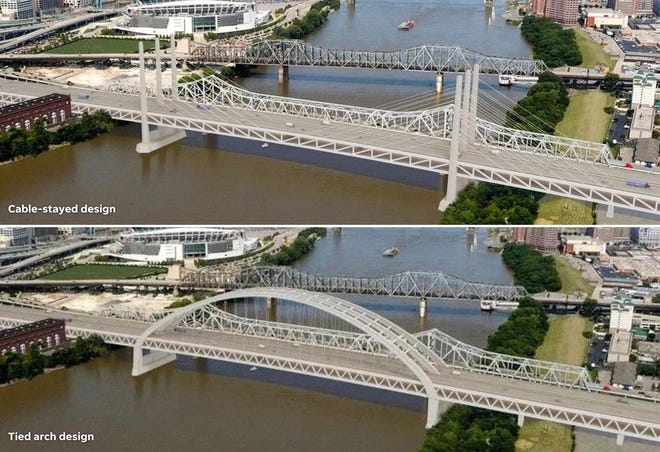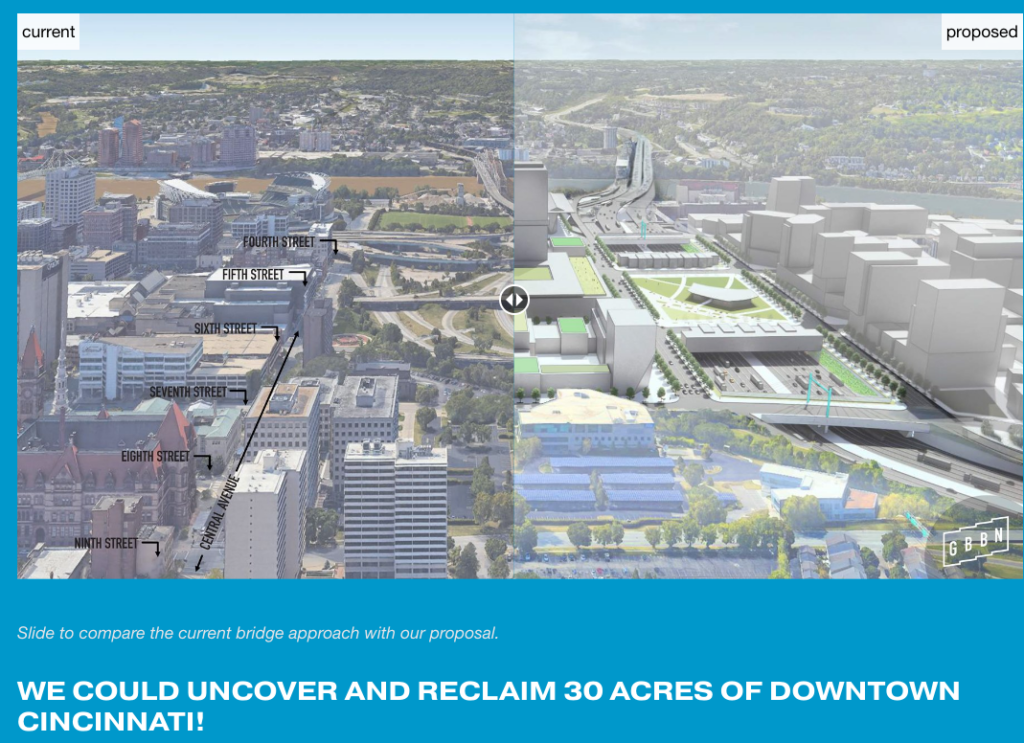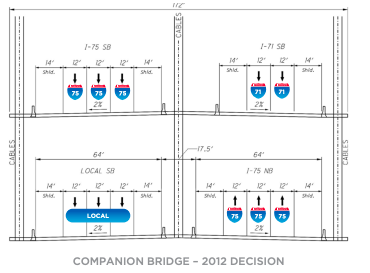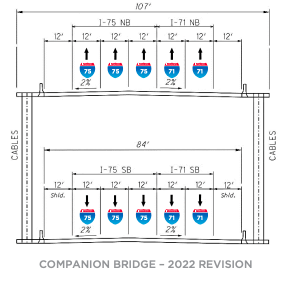There’s plenty of time to fix the Interstate Bridge Project
Contrary to claims made by OregonDOT and WSDOT officials, the federal government allows considerable flexibility in funding and re-designing, especially shrinking costly and damaging highway widening projects
In Cincinnati, the $3.6 billion Brent Spence Bridge Project
- Was downsized 40 percent without causing delays due to environmental reviews
- Got $1.6 billion in Federal grants, with only about $250 million in state funding plus vague promises to pay more
- Is still actively looking to re-design ramps and approaches to free up 30 acres of downtown land
For years, the managers of the Interstate Bridge Project have been telling local officials that if they so much as changed a single bit of the proposed IBR project, that it would jeopardize funding and produce impossible delays. Asked whether it’s possible to change the design, and they frown, and gravely intone that “our federal partners” would be displeased, and would not allow even the most minor change. It’s a calculated conversation stopper—and it’s just not true.
Across the country, in Cincinnati, local leaders–who’ve already gotten a commitment of $1.6 billion in federal funds—based on a modest down payment and vague commitments to pay more. Collectively, Kentucky and Ohio still have to figure out where about $1.5 billion in state funding will come from.

Last year, in response to local government concerns, the two state DOTs reduced the size of the Brent Spence Bridge by 40 percent from the version that the Ohio and Kentucky DOTs pushed through the environmental review process. And that change isn’t expected to affect its environmental approvals or timetable.
Not only that, but local governments–led by Cincinnati—are still actively pushing for a major re-design of the bridge’s on- and off-ramps to free up 40 acres of land in downtown Cincinnati for urban redevelopment—something that they believe can be done without jeopardizing the project.
This is an object lesson for Oregon and Washington: The federal government doesn’t require all local funding to be in place before it makes its commitment, it’s possible to shrink a project even after its gotten its environmental approval, and its also possible, even after getting the federal funding, to make major changes to the project design to lessen its impact on urban spaces.
As Metro President David Bragdon observed, Oregon and Washington DOT officials routinely lie about federal requirements and deadlines to block local officials from designing better and more affordable highway projects.
Leadership at ODOT frequently told me things that were not true, bluffed about things they did not know, made all sorts of misleading claims, and routinely broke promises. They continually substituted PR and lobbying gambits in place of sound engineering, planning and financial acumen, treating absolutely everything as merely a challenge of spin rather than matters of dollars or physical reality. . . . ODOT management has revived one of its favorite old falsehoods by claiming they are facing an “imminent federal deadline,” and that if local leaders don’t knuckle under to ODOT’s plan–and soon–the region will lose millions or tens of millions of dollars forever. Creating fictional “federal deadlines” and other federal processes as an excuse for false urgency is a familiar ODOT tactic.
For too long, highway officials have gotten away with their best Jerry Lundegaard impressions, telling state and local officials that their hands are tied, because their manager (in another room) just won’t approve a better deal or not charging for the under-coating. Cincinnati’s Brent Spence project shows the federal government will allow changes that make highway projects have fewer environmental impacts, become more affordable, and benefit local communities.
Honey: I shrank the bridge
The original design for the Brent Spence Bridge was approved by the US Department of Transportation in a “Finding of No Significant Environmental Impact, (FONSI)” in 2012. As originally proposed, the bridge would have been nearly 150 feet wide. Not only was this design over-sized (and expensive) but it had significant impacts on the City of Covington Kentucky (the southern terminus of the new bridge). The project languished without funding for more than a decade.
In 2022, the Kentucky and Ohio Departments of Transportation agreed to significantly reduce the width of the project. They width of the double-decker bridge was reduced from 145.5 feet to 84 feet.
In June, 2022, the new, much more compact design was announced:
Based on engagement and technical analysis, the announced Friday said, the footprint of the new bridge has been significantly reduced from the alternative approved in 2012. . . . . The new bridge was planned to cover nearly 25 acres and span nearly 150 feet in width. Revised plans show the new bridge at almost half the size of the 2012 footprint – covering approximately 14 acres and 84 feet in width. (emphasis added)
This was a major concession to local leaders:
Covington Mayor Joe Meyer, led the negotiation for the City, called the agreement a monumental victory for Covington residents and businesses. . . . “Meyer said it will “reduce the width of the driving companion bridge by over 40 %. It’s a 61 and a half foot reduction in the driving width of that bridge.They’ve reduced the additional right of way that was necessary by 10 acres, another 40 plus percent reduction in right of way acquisition.”
The Federal Highway Administration is being asked to “re-evaluate” it s NEPA approval. The Kentucky and Ohio transportation departments are preparing an updated Environmental Assessment, and FHWA is expected to issue a revised “FONSI” this Fall. The key argument made by the state transportation departments is that the new, smaller design is within the “footprint” of the already approved 2012 design, and therefore can be expected to have fewer environmental impacts.
Here’s the lesson for Oregon and Washington: Just because the decade-old plans for your bridge called for a massively wider freeway, nothing in the federal environmental review process precludes you from making the project smaller. That won’t slow down the environmental review process, and it’s no obstacle to getting federal funding. For the proposed Interstate Bridge Replacement project, this means that a right-sized bridge, coupled with retaining (rather than replacing) existing interchanges, would likely get FHWA approval.
The bridge is approved: Now let’s re-design it
The current design for the Brent Spence Bridge is now 40 percent smaller than it was a year ago—but the re-design is not over. Like the proposed Interstate Bridge Replacement Project, the Brent Spence “Corridor” project calls for an expensive set of on- and off-ramps to connect to the new bridge. On the Cincinnati side of the river, this spaghetti of ramps and intersections would foreclose the urban use of more than 30 acres of prime real estate in the city’s downtown. Rather than repeat the devastating mistakes of past freeway construction–which obliterated most of Cincinnati’s historically Black neighborhoods–local leaders are calling for a re-design of Brent Spence’s ramps and connections to restore urban use.
Keep in mind that President Biden announced the approval of federal funding in January of this year. Right now, in May, 2023, the Cincinnati City Council is pushing forward with plans to re-design the project as it passes through the city. The current Cincinnati Mayor, Aftab Pureval, and two former Mayors, John Cranley and Mark Mallory—have all spoken out in favor of a fundamental re-design of the Brent Spence Bridge to dramatically shrink its complex of interchanges and off-ramps, and free up more than 30 acres of land that were devastated by freeway construction. They’re calling on the Ohio Department of Transportation, and US DOT Secretary Pete Buttigieg, to give them flexibility to re-design the project—something the city has done successfully with other highways in Cincinnati:
We also applaud Transportation Secretary Pete Buttigieg (whom we have both known for many years) for implementing new rules that reward designs that are urban friendly. The federal government now embraces the kind of progressive vision our city showed in redoing Fort Washington Way and the I-71/MLK interchange.
The progressive design build process that ODOT has rightly put in place requires that local input be an official part of selecting a contractor and finalizing with that contractor a design that meets local goals and ambitions. That process has only just begun and any suggestion that it is “too late” to make design improvements isn’t paying attention to recent changes ushered in by Secretary Buttigieg.
A local group, called Bridge Forward, has come up with a plan to reduce the footprint of the onramps, and trigger urban renovation:

This has a direction implication for the Interstate Bridge Replacement Project in Portland and Vancouver. In their $7.5 billion project, ODOT and WSDOT are proposing to re-create, and rebuild at great expense, seven closely spaced freeway interchanges, which they—and independent consultants they hired—have said are a fundamental cause of the highway congestion and which are a majority of the cost of the bloated project.
As Cincinnati’s experience shows, even after the bridge has been down-sized, and the federal money committed, there’s still the opportunity to get a more sensible, sensitive design.
The Ohio experience with the Brent Spence Bridge shows that, if local leaders are in agreement, we can shrink the size of the project to reduce its cost, and continue to explore designs that are less disruptive to the urban fabric without slowing down the federal funding, environmental approval, or construction contracting processes.
No money down: The Feds contributed to the project in return for partial state funding and vague commitments, not hard cash
A key talking point of the Oregon and Washington DOTs is that Oregon has to put $1 billion on the table in order to apply for federal funds. That’s clearly not the case with the Brent Spence Bridge. Local television news station WKRC reported that President Biden committed $1.6 billion in federal funds for the project’s total cost, estimated at $3.5 billion. So far the only state commitments are a $250 million pledge from the Kentucky legislature and an vague statement from Ohio Governor that his state would “pay its share: That leaves more than $1.5 billion that the two states expected have yet to come up with, as WKRC reported:
That leaves another $1.5 billion in costs to be split between Ohio and Kentucky. The Kentucky General Assembly last year pledged $250 million toward the project, with Ohio Gov. Mike DeWine also promising his state would pay its share.



